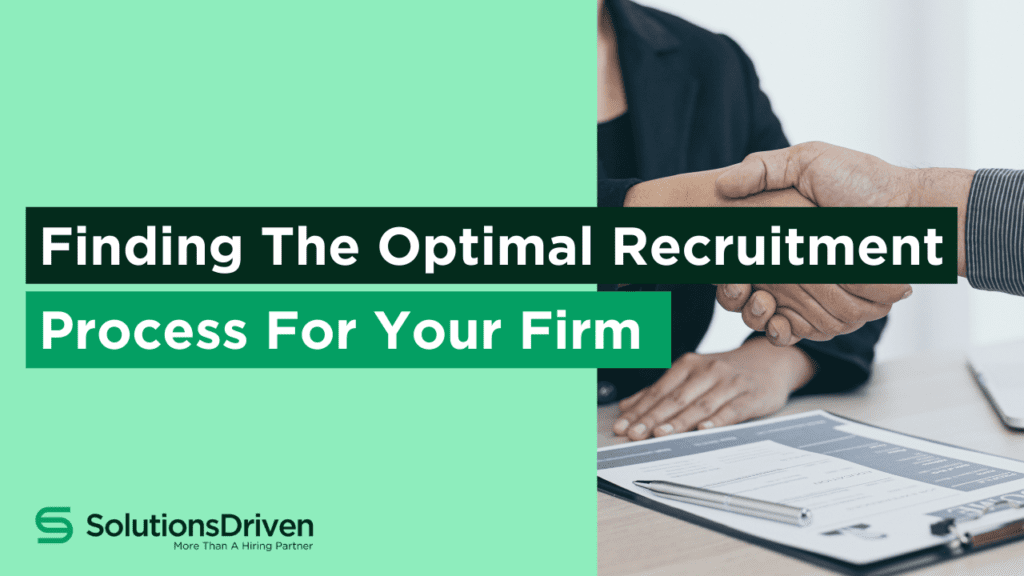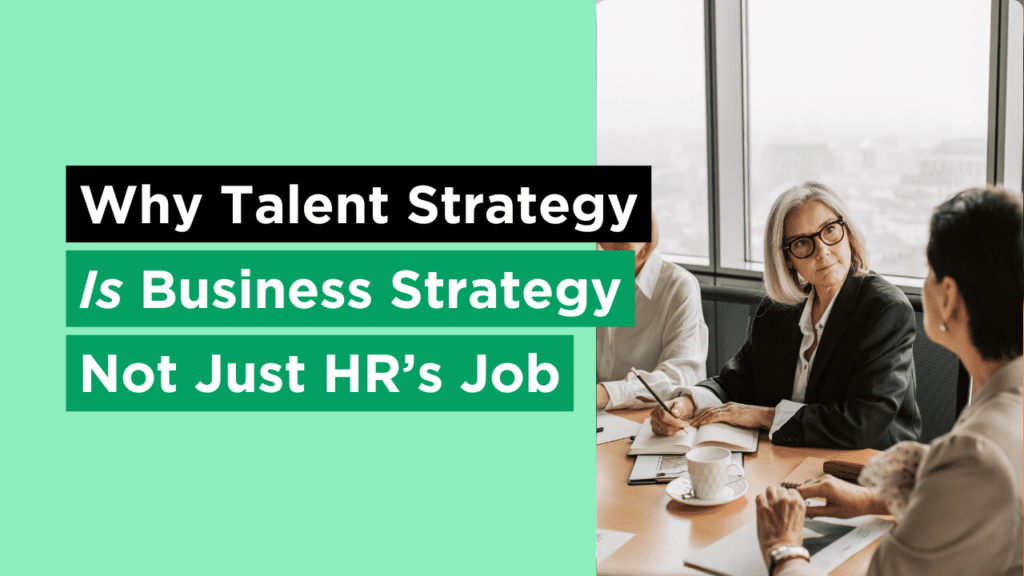In the fast-paced & ever-evolving world of business, talent acquisition & recruitment remain critical pillars for any business building a resilient & dynamic workforce. In the modern market, there’s no shortage of different recruitment models to utilise, including: embedded recruitment teams, in house talent acquisition, head-hunters, and outsourced recruitment firms.
With so many recruitment processes at your disposal, you can find the optimal HR recruitment process for your firm & ensure it is tailored to the specific needs & culture of your firm, allowing you to set your team up so sustainable success. An effective recruitment strategy should not only align with your company’s objectives but also ensure that the most talented candidates on the market are identified, engaged, and onboarded, in the most efficient manner possible.
There are many variables to consider when selecting which recruitment processes to use when hiring for a specific role, from the initial stages of identifying staffing requirements, through to onboarding your new team members. We’ll highlight the factors you should be considering when choosing the right recruitment process for your firm.
Understanding Different Recruitment Processes
As the recruitment industry has evolved over the decades, processes have been developed & iterated upon, to create modern & efficient recruitment processes tailored for different situations. With each process having unique characteristics & advantages for different hiring scenarios, which makes it crucial for firms to go forward with a process that aligns best with their strategic goals & operational dynamics.
Traditional Recruitment
Traditional recruitment methods, such as newspaper ads, job board postings, and in-person interviews, have been a go-to recruitment process that organisations have used for decades. Despite being time-consuming & often costly, these traditional methods often provide a sense of familiarity & simplicity to business owners and HR managers.
Companies still using traditional methods may face challenges such as: a limited candidate pool, hindering a firm’s ability to secure industry-leading talent; time consuming vetting & interview processes, which can cause time to hire and cost to hire to spiral; and potential biases in human decision-making, which can impact diversity & innovation within the workforce.
Embedded Recruitment
Embedded recruitment is an efficient recruitment process, which integrates a specialist team of external recruiters directly into a company’s internal team.
By embedding external recruiters into your company, allows them to develop a deep understanding of your company’s culture & operational needs, allowing the external recruiters to tailor their recruitment strategies effectively.
A team of embedded recruiters will participate in regular internal meetings, assist in drafting job descriptions, and offer negotiation tips, making the process more aligned with their client’s long-term objectives. Financial predictability & rapid deployment are key benefits of this model, especially for startups & scale-ups needing to expand their workforce efficiently.
Executive Search
Executive search is a specialised recruitment process which has been tailored to hiring for executive & C-Suite level positions by engaging with passive candidates who are not actively seeking new opportunities.
The executive search process requires recruitment teams to work closely with clients to develop a deep understanding of their needs & use their extensive networks to attract high-caliber candidates, who can fill a leadership role.
This process is often highly confidential & often involves a retainer fee, reflecting the in-depth advisory & bespoke nature of the service, as the recruitment team will identify & engage with ideal candidates for executive roles.
Confidential Hiring
Confidential hiring is crucial when discretion is paramount, such as when a current role holder is unaware of their impending replacement. This process helps protect the company’s reputation & attracts candidates from diverse industries by maintaining anonymity. Confidential searches are particularly useful for sensitive positions or when companies are exploring strategic changes that they wish to keep undisclosed.
Flexible Project Recruitment
The increasing need to quickly scale teams in the workforce has given rise to flexible project recruitment, which is a recruitment process involving a mix of permanent & temporary roles, allowing companies to manage recruitment costs effectively & adapt to fluctuating workloads.
Flexible recruitment not only helps in scaling operations according to current needs but also enhances employee retention by providing security during economic downturns.
Factors to Consider When Choosing a Recruitment Process
When choosing which recruitment process to deploy for your firm, it is essential to evaluate several critical factors to ensure the chosen method aligns with strategic objectives & operational needs. Here are key considerations:
Industry & Market Dynamics
The industry’s pace & competitive landscape will heavily influence which recruitment strategies should be deployed. For example: competitive, fast paced industries such as technology & finance, where innovation & rapid skill development are crucial, may require more dynamic & flexible recruitment processes.
Understanding the overarching market trends at play, as well as the availability of talent within specific industries can guide firms in choosing a recruitment process that will secure access to top industry talent.
Hiring Volume & Frequency
Companies should also evaluate their hiring needs in terms of both volume & frequency of hiring. Companies in industries with high turnover rates or those in growth phases will likely benefit from a streamlined, scalable recruitment process to keep up with demand. In contrast, companies with lower turnover would benefit from a more detailed, bespoke recruitment approach, which focuses on identifying & engaging with top industry talent and improving talent retention.
Budget & Resources
The financial element of recruitment cannot be overlooked; firms must assess their budget for recruitment activities, which includes costs associated with advertising positions, employing recruitment agencies, and potentially training in-house HR teams. Smaller firms or those with stringent budget constraints might consider cost-effective solutions like embedded recruitment teams or outsourced recruitment services that offer flexibility without a significant upfront investment.
Existing HR Capabilities
The current capabilities & capacity of a firm’s HR department play a crucial role when looking to find the most efficient recruitment process for a firm.
A well-equipped HR team with experience in successfully filling vacant positions can handle more complex parts of the hiring processes internally. On the other hand, firms with less experienced HR teams, or less developed HR practices will benefit from working with an experienced recruitment partner, that brings experience and proven tactics to the table.
Specific Hiring Goals
Finally, companies need to consider & define their organisations specific hiring goals, to select a process that aligns with the goals of the company.
Whether looking to fill positions quickly, find highly specialised talent, or prioritising diversity & inclusion, the recruitment process chosen should directly support these objectives. For instance, if an organisation wants to foster a culture of diversity and inclusion, they should utilise a recruitment process that reviews their existing processes to eliminate biases, and tap into broader, more diverse talent pools.
By carefully considering these factors, firms can tailor their recruitment strategies to meet both immediate hiring needs & long-term business goals, ultimately securing a competitive edge in the market.
Implementing Your Chosen Recruitment Process
Once your firm has chosen which recruitment process to move forward with, implementing it effectively is crucial for ensuring success not only in filling a vacant role, but ensuring long-term staff retention.
Planning & Resource Allocation
The first step in implementing your chosen recruitment process involves detailed planning & allocation of resources; defining clear roles & responsibilities for their HR teams & recruitment partners, while also allocating adequate resources to support the recruitment process.
Setting realistic timelines for each recruitment phase & ensuring that the budget aligns with the expected recruitment volumes; proper planning helps to avoid resource shortages & allows the recruitment process to run smoothly without unnecessary delays.
Technology & Tools Required
In the modern talent acquisition landscape, it is important to leverage software when recruiting staff, to help streamline the process and maximise the efficiency of your hiring partners. You should invest in recruitment software that supports their specific hiring needs, such as applicant tracking systems (ATS), candidate relationship management (CRM) tools, and data analytics platforms.
These technologies help in automating routine tasks, improving candidate engagement, and providing insightful data that can guide decision-making throughout the recruitment process.
Integration with Existing HR Systems
To maximise efficiency when hiring, your chosen recruitment process should be fully integrated with any existing HR systems and protocols. Integrating your recruitment process into your HR systems allows for a unified approach to managing candidate data, employee records, and other HR functions. It reduces the risk of data silos & ensures that all information is accessible when needed.
Training & Development for HR Teams
Equipping in-house HR & TA teams with the necessary skills & training is fundamental to successfully implementing any recruitment process, no matter if it is handled in-house or utilises an external hiring partner. Companies should provide comprehensive training programs to ensure that all internal HR & TA teams can effectively use new technologies, understand the best practices in candidate engagement, and are fully aware of any legal compliance issues they may run into.
Ongoing development opportunities should also be offered to ensure that HR professionals stay updated with the latest trends & techniques in talent acquisition.
Monitoring & Evaluation Plan
Finally, establishing a robust monitoring & evaluation plan is critical to assess the effectiveness of the implemented recruitment process. Companies should define key performance indicators (KPIs) such as time-to-hire, cost-per-hire, and candidate satisfaction rates. Regular assessments allow companies to identify areas for improvement & make necessary adjustments to the recruitment strategy. This iterative process ensures continuous enhancement & helps firms maintain a competitive edge in talent acquisition.
By carefully executing these steps, companies can ensure that their chosen recruitment process is implemented effectively, leading to the successful acquisition of top talent & contributing to overall business growth.
Best Practices for Successful Recruitment
Maintaining flexibility & adaptability in recruitment processes is crucial for firms aiming to stay competitive in a rapidly changing market. Companies should be prepared to adjust their strategies based on evolving industry trends, technological advancements, and changes in the workforce. This approach not only helps in tapping into diverse talent pools but also ensures that recruitment strategies can swiftly adapt to unforeseen circumstances, reducing the risk of talent acquisition disruptions.
Fostering good candidate relationships is another cornerstone of successful recruitment. Organisations should strive to create a positive & engaging experience for all candidates, regardless of the outcome of their application. This involves clear communication throughout the recruitment process, timely feedback, and respectful interactions. Building such relationships can enhance the company’s reputation in the job market, increase candidate engagement, and encourage high-quality applicants to reapply in the future, which will create a valuable talent pipeline you can revisit as new roles become vacant.
Legal & ethical considerations are paramount in designing & implementing recruitment processes. Companies must ensure compliance with all relevant employment laws, including anti-discrimination regulations & privacy laws. Ethical practices, such as maintaining confidentiality & providing equal opportunities for all candidates, are essential to uphold the integrity of the recruitment process & protect the company from legal challenges. Adhering to these principles not only fosters trust among prospective employees but also solidifies the firm’s standing as a fair & reputable employer.
By integrating these best practices into their recruitment strategies, firms can enhance their ability to attract & retain top talent, while also promoting a positive corporate image & adhering to legal & ethical standards.
Common Mistakes to Avoid When Recruiting
Overreliance on Technology: While technology plays a crucial role in modernising & streamlining the recruitment process, an overdependence on automated systems can lead to significant drawbacks. Firms that rely too heavily on technology may miss out on high-quality candidates & applicants who don’t perfectly match the criteria set out by software and algorithms, but would otherwise be excellent fits for both the company culture & job requirements. It’s essential to maintain a balance between utilising technological tools & preserving the human element in recruitment decisions.
Neglecting Candidate Experience: The candidate experience during the recruitment process significantly impacts an organisation’s ability to attract & retain top talent; neglecting this aspect can result in a negative perception of the company, deterring potential candidates from applying or accepting job offers. Companies should ensure clear communication, respect candidates’ time by scheduling & conducting interviews efficiently, and provide feedback to enhance the overall candidate experience. This approach not only improves the chances of hiring the right candidates but also boosts the company’s reputation in the job market.
Insufficient Planning & Forecasting: A common mistake in recruitment is the lack of proper planning & forecasting. Without a strategic plan, companies can experience either a talent surplus or shortage, both of which can have detrimental effects on operational efficiency & financial performance. Effective recruitment requires a clear understanding of current & future workforce needs, aligning them with business goals & market conditions. Companies should implement regular planning sessions & keep their strategies flexible to adapt to sudden changes in the market or in the organisation.
Ignoring Employer Branding: Employer branding is a key component of any successful recruitment strategy, yet it is often overlooked. A strong employer brand will help attract candidates by showcasing the company as a desirable place to work. Ignoring employer branding can make it challenging to attract high-calibre candidates, especially in competitive job markets like Technology & Science. Companies should actively promote their values, culture, and employee benefits through various channels such as social media, corporate websites, and in-office to enhance their visibility & appeal to potential employees. By investing in employer branding, firms not only improve their recruitment outcomes but also their overall market position.
When exploring which recruitment processes are right for your firm, you should understand the importance of selecting & implementing a strategy that aligns with your firm’s long-term goals. By weighing up the advantages & considerations associated with various recruitment models, from traditional methods to more innovative approaches like embedded recruitment & confidential hiring, it provides a solid foundation for companies to navigate the complex landscape of talent acquisition.
As the modern business and talent landscapes continue to evolve, the importance of reviewing & adapting recruitment strategies to meet changing needs cannot be overstated. This continuous evolution encourages firms to remain agile, adjusting their recruitment processes as necessary to align with broader industry trends & internal growth objectives.






